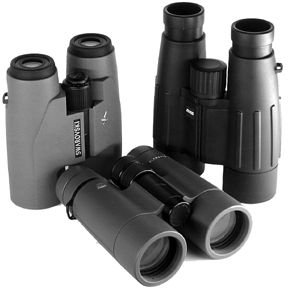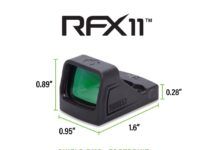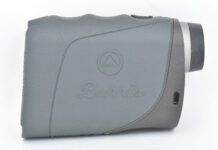
Experienced hunters know a quality pair of binoculars can be one of their most important pieces of equipment, right behind a good pair of boots. In fact, many hunters believe (correctly) that they can buy an inexpensive gun and still get a shooter, but few of them believe in skimping on glass quality. They believe another $500 to $1,000 in optics cost translates into another 30 seconds of prime shooting time, or the ability to see the two short drop tines that separate an 8-pointer from a shooter 10-point buck.
In this two-part test, we tested six models of binoculars. All of the models were 10X42, which means the image is magnified 10 times, and the objective lens diameter is 42mm, which determines the amount of light reaching your eyes. The brands included three German-made binoculars – the Zeiss Victory FL, Leica Ultravid, and Steiner Peregrine; two models made in Japan – the Leupold Wind River Pinnacle and the Bushnell Legend; and one from Austria – the Swarovski SLC.
We acquired all the products from SWFA, 420 Century Way, No. 100, Red Oak, TX 75154; (972) SCOPE-IT (726-7348), www.swfa.com. All the prices listed for the glasses are SWFA’s current retail prices, rounded to the nearest major dollar break.
In the April 2005 issue, we tested three less expensive units: the Bushnell 10X42 Legend Binoculars Mod. 130142, $260; the Leupold Wind River 10X42 Pinnacle Binoculars Mod. LEU54514, $400; and the Steiner 10X42 Peregrine Binoculars No. 358, $900. Of the three, we thought the Leupolds offered the best combination of price and function.
This round, we look at three units whose retail prices fall in the four-digit range: the Swarovski 10X42 SLC Binoculars No. 58010, $1,180; the Zeiss 10X42 Victory FL Binoculars Model 524522, $1,450; and the Leica 10X42 Ultravid Binoculars No. 40267, which at $1,700 were the most expensive glasses in the test.
We can say upfront that these binoculars are all excellent units, and we would be confident in recommending any of the three. But our test group liked one brand better than the others, and if it were our money, we would pick it first among equals.
SWFA’s Chris Farris said, “If a customer is choosing between Swarovski, Zeiss, and Leica, as a retailer, we can be assured that the customer will be happy with whichever model he chooses. They are all superior products. But it might surprise you to learn that there can be subjective differences to take into account.”
To cover a variety of situations where binoculars would be a valuable tool, we selected several test objects or targets that were placed at various ranges. We had a pool of examiners gauge the glasses on a range of subjective areas, in field tests that reflected how the glasses might be used. In one test, we put out two stuffed quail in the brush at 30 yards and at 100 yards. Color and brightness of the image were the test factors for the stuffed bird test.
To judge the models’ service during a deer hunting situation, a life-sized target and a mounted set of antlers were placed at 100 yards. Brightness and clear view of the full-body image were test factors, and the antlers presented an interesting twist to the view ranking. Although the rack appeared to be a typical 10-point whitetail deer, an eleventh point – this one with its own base – stuck out about an inch from the bottom of the right-hand side of the antlers. Picking out the extra point was the tiebreaker in this test.
In a long-distance test, a metal deer blind was examined with all the models at a distance of 400 yards to determine how many details could be observed.
And on a shooting range, we placed various eye charts and shot targets to see how well paper could be read by the recreational shooter. Members of our group who wear prescription glasses tested the models both with and without eyewear. Here is our report:
[PDFCAP(1)]
The only Austrian-made submission to the test group was the Swarovski 10X42 SLC Binoculars. The United States contact is Swarovski Optik North America Limited, 2 Slater Road, Cranston, RI 02920-9957; (800) 426-3089, <www.swarovskioptik.com>.
At close ranges, views of the stuffed quail were bright and the color really popped. Even the tiny breast feathers slightly moving in the breeze were clearly visible.
Moving out to 100 yards, both the deer target and set of antlers were bright and clear. As a side note, even the .30-caliber bullet holes in a target near our test items were clearly visible.
Brightness and clarity at long range were both excellent. Rust spots could be made out on the side of the deer stand. Adjustment of the interpupillary distance was very easy and quick. The model weighed in at 30.7 ounces, but with the extra-large thumb groves and the non-slip covering, there were no handling problems.
[PDFCAP(2)]
Falling between the other two German binoculars was the Zeiss 10X42 Victory FL Binoculars. The United States contact is Zeiss Sports Optics, 13005 N. Kingston Ave., Chester, VA 23836-9902; (800) 441-3005, <www.zeiss.com>.
From the packaging to the way this model feels when put to use, there is an element of quality that stands out above the rest, in our view.
Crystal-clear images at all ranges, from bright colors on the stuffed birds’ feathers to rust spots on the long-range view of the deer blind found favor with our test group. The Zeiss model weighs just 26.8 ounces, making it one of the lighter binoculars in our test collection. Our group was very impressed with the handling ability and the bright, crisp quality of images seen through the lens. The model was quick and easy to focus for both our testers who wore glasses and those who did not, with a simple twist required to adjust the eye cups.
Interpupillary adjustments were also very simple.
The quality carrying case and strap were a solid addition to the features of this model.
[PDFCAP(3)]
Also made in Germany, our highest-priced test optics were the Leica 10X42 Ultravid Binoculars No. 40267, $1,699.99. The contact in the United States is Leica Camera Inc., 156 Ludlow Ave., Northvale, NJ 07647-2308; (800) 222-0118, <www.leica-camera.com>.
True to our expectations for a high-dollar model, these binoculars provide an excellent, clear, sharp view of test items at all ranges. Probably presenting the brightest view of all the test models, the Leicas were easy to handle and offered quick adjustments for both interpupillary distance and eye relief. As with the other high-end models, adjusting the eye cups to accommodate testers with or without eye glasses required a simple twist of the wrist.
The weight of the model was 27.3 ounces, slightly higher than the published weight of 27 ounces. Very bright and bold images at all ranges resulted in high marks from our test group, whose only minor concern was the price tag.
Gun Tests Recommends
• Swarovski 10X42 SLC Binoculars No. 58010, $1,180. Buy It. This unit provides excellent images at all ranges, and its price tag is substantially less than the Zeiss glass. Our group was very impressed with the compact feel of this model.
• Zeiss 10X42 Victory FL Binoculars Model 524522, $1,450. Our Pick. Finding the money to pay for this model is well worth the effort, with sharp and crisp images at all ranges. It had image quality equal to the Leicas for substantially less money, and we thought the Victory was brighter than the Swarovskis, but the differences were minimal.
• Leica 10X42 Ultravid Binoculars Model 40267, $1,700. Conditional Buy. Optically, there’s nothing whatsoever wrong with this unit. Although the price tag is high, the quality of performance is very good with this solid, easy-to-use pair of binoculars. But for $250 less, we liked the Zeiss better.




























